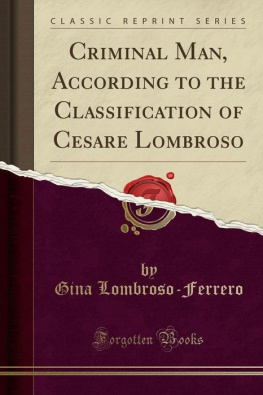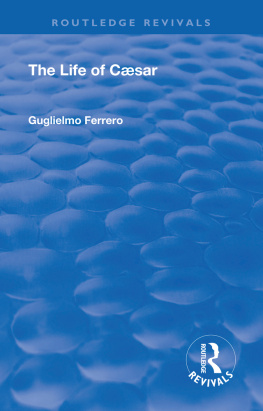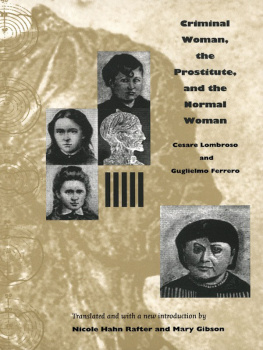Cesare Lombroso (born Ezechia Marco Lombroso; Italian; 6 November 1835 19 October 1909), was an Italian criminologist, physician, and founder of the Italian School of Positivist Criminology.
Lombroso rejected the established classical school, which held that crime was a characteristic trait of human nature. Instead, using concepts drawn from physiognomy, early eugenics, psychiatry and Social Darwinism, Lombroso's theory of anthropological criminology essentially stated that criminality was inherited, and that someone "born criminal" could be identified by physical (congenital) defects, which confirmed a criminal as savage or atavistic.
The text of this book is available on www.gutenberg.org
Fabio Di Benedetto, 2015. Edition 3.0
All rights reserved. No part of this publication may be reproduced, distributed, or transmitted in any form or by any means, including photocopying, recording, or other electronic or mechanical methods, without the prior written permission of the publisher, except in the case of brief quotations embodied in critical reviews and certain other noncommercial uses permitted by copyright law.
Introduction by Cesare Lombroso
Professor Lombroso was able before his death to give his personal attention to the volume prepared by his daughter and collaborator, Gina Lombroso Ferrero (wife of the distinguished historian), in which is presented a summary of the conclusions reached in the great treatise by Lombroso on the causes of criminality and the treatment of criminals. The preparation of the introduction to this volume was the last literary work which the distinguished author found it possible to complete during his final illness.
It will, perhaps, be of interest to American readers of this book, in which the ideas of the Modern Penal School, set forth in my work, Criminal Man, have been so pithily summed up by my daughter, to learn how the first outlines of this science arose in my mind and gradually took shape in a definite work how, that is, combated by some, the object of almost fanatical adherence on the part of others, especially in America, where tradition has little hold, the Modern Penal School came into being.
On consulting my memory and the documents relating to my studies on this subject, I find that its two fundamental ideas that, for instance, which claims as an essential point the study not of crime in the abstract, but of the criminal himself, in order adequately to deal with the evil effects of his wrong-doing, and that which classifies the congenital criminal as an anomaly, partly pathological and partly atavistic, a revival of the primitive savage did not suggest themselves to me instantaneously under the spell of a single deep impression, but were the offspring of a series of impressions. The slow and almost unconscious association of these first vague ideas resulted in a new system which, influenced by its origin, has preserved in all its subsequent developments the traces of doubt and indecision, the marks of the travail which attended its birth.
The first idea came to me in 1864, when, as an army doctor, I beguiled my ample leisure with a series of studies on the Italian soldier. From the very beginning I was struck by a characteristic that distinguished the honest soldier from his vicious comrade: the extent to which the latter was tattooed and the indecency of the designs that covered his body. This idea, however, bore no fruit.
The second inspiration came to me when on one occasion, amid the laughter of my colleagues, I sought to base the study of psychiatry on experimental methods. When in '66, fresh from the atmosphere of clinical experiment, I had begun to study psychiatry, I realised how inadequate were the methods hitherto held in esteem, and how necessary it was, in studying the insane, to make the patient, not the disease, the object of attention. In homage to these ideas, I applied to the clinical examination of cases of mental alienation the study of the skull, with measurements and weights, by means of the esthesiometer and craniometer. Reassured by the result of these first steps, I sought to apply this method to the study of criminals that is, to the differentiation of criminals and lunatics, following the example of a few investigators, such as Thomson and Wilson; but as at that time I had neither criminals nor moral imbeciles available for observation (a remarkable circumstance since I was to make the criminal my starting-point), and as I was skeptical as to the existence of those "moral lunatics" so much insisted on by both French and English authors, whose demonstrations, however, showed a lamentable lack of precision, I was anxious to apply the experimental method to the study of the diversity, rather than the analogy, between lunatics, criminals, and normal individuals. Like him, however, whose lantern lights the road for others, while he himself stumbles in the darkness, this method proved useless for determining the differences between criminals and lunatics, but served instead to indicate a new method for the study of penal jurisprudence, a matter to which I had never given serious thought. I began dimly to realise that the a priori studies on crime in the abstract, hitherto pursued by jurists, especially in Italy, with singular acumen, should be superseded by the direct analytical study of the criminal, compared with normal individuals and the insane.
I, therefore, began to study criminals in the Italian prisons, and, amongst others, I made the acquaintance of the famous brigand Vilella. This man possessed such extraordinary agility, that he had been known to scale steep mountain heights bearing a sheep on his shoulders. His cynical effrontery was such that he openly boasted of his crimes. On his death one cold grey November morning, I was deputed to make the











